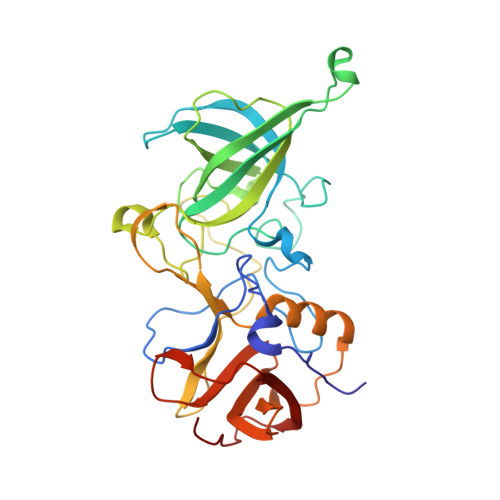Fucose-Functionalized Precision Glycomacromolecules Targeting Human Norovirus Capsid Protein.
Bucher, K.S., Yan, H., Creutznacher, R., Ruoff, K., Mallagaray, A., Grafmuller, A., Dirks, J.S., Kilic, T., Weickert, S., Rubailo, A., Drescher, M., Schmidt, S., Hansman, G., Peters, T., Uetrecht, C., Hartmann, L.(2018) Biomacromolecules 19: 3714-3724
- PubMed: 30071731
- DOI: https://doi.org/10.1021/acs.biomac.8b00829
- Primary Citation of Related Structures:
6GY9 - PubMed Abstract:
Norovirus infection is the major cause of nonbacterial gastroenteritis in humans and has been the subject of numerous studies investigating the virus's biophysical properties and biochemical function with the aim of deriving novel and highly potent entry inhibitors to prevent infection. Recently, it has been shown that the protruding P domain dimer (P-dimer) of a GII.10 Norovirus strain exhibits two new binding sites for l-fucose in addition to the canonical binding sites. Thus, these sites provide a novel target for the design of multivalent fucose ligands as entry inhibitors of norovirus infections. In this current study, a first generation of multivalent fucose-functionalized glycomacromolecules was synthesized and applied as model structures to investigate the potential targeting of fucose binding sites in human norovirus P-dimer. Following previously established solid phase polymer synthesis, eight precision glycomacromolecules varying in number and position of fucose ligands along an oligo(amidoamine) backbone were obtained and then used in a series of binding studies applying native MS, NMR, and X-ray crystallography. We observed only one fucose per glycomacromolecule binding to one P-dimer resulting in similar binding affinities for all fucose-functionalized glycomacromolecules, which based on our current findings we attribute to the overall size of macromolecular ligands and possibly to steric hindrance.
- Heinrich-Heine-University Düsseldorf , Institute for Organic Chemistry and Macromolecular Chemistry , Düsseldorf , Germany.
Organizational Affiliation:


















